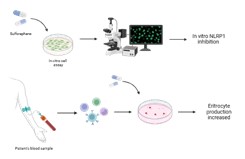Hematopoiesis generates blood cells from stem cells in the bone marrow, ensuring essential functions like oxygen transport, immune defense, and coagulation. Erythropoiesis regulates red blood cell production, influenced by erythropoietin, iron, vitamin B12, and folate. Dysregulation can cause genetic disorders like sideroblastic anemia and thalassemia, though their causes and treatments differ.
Thalassemia is a genetic disorder that affects globin production, generating abnormal erythrocytes and anemia, and is treated with transfusions, chelation, bone marrow transplantation and gene therapy in some cases. Sideroblastic anemia, on the other hand, is due to a failure in the incorporation of iron into hemoglobin, causing its accumulation in the erythroid precursors, and is managed with vitamin B6, chelation and transplantation in severe cases. Recently, new therapeutic alternatives have been developed, such as gene therapies, which have been approved by the FDA and EMA for the treatment of thalassemia. However, they are still considered rare diseases with still limited therapeutic resources. For this reason, researchers at the Instituto Murciano de Investigación Biotecnológica (IMIB), in Spain, have developed a new approach to the treatment of thalassemia and anemia through a natural compound obtained from vegetables sources such as broccoli.
The technology involves a natural compound, the sulforaphane, capable of inhibiting the NLRP1 inflammasome, which is a sensor protein that is part of the inflammasome. This multiprotein complex is responsible for the activation of inflammatory processes and induces cell pyroptosis.
It has been shown that sulforaphane has a positive effect on the production of erythrocytes, being able to restore erythropoiesis in ex-vivo primary cell from patients with thalassemia and sideroblastic anemia. Therefore, it could be used as a drug for the treatment and prevention of these serious diseases.

The technology is at a TRL 3-4. Several ex vivo trials have been carried out on samples from thalassemia and sideroblastic anemia patients’ cells, advancing the validation of its efficacy and therapeutic potential.
Benefits:
- It introduces a new strategy based on the inhibition of the NRLP1 inflammasome, being able to modulate the inflammation and restore erythropoiesis in thalassemia and sideroblastic anemia patients’ cells.
- It may reduce the need for blood transfusions and iron chelation therapies in these patients.
- It offers a new therapeutic option for very rare pathologies with limited treatment options.
- The compound can be extracted from natural sources and administered by different routes.
The represented institution is looking for a collaboration that leads to commercial exploitation of the presented invention.
Institution: Instituto Murciano de Investigación Biotecnológica (IMIB)
TRL: 3-4
Protection status: Patent applied for under the name Sulforaphane for the treatment of thalassemia and sideroblastic anemia (P202430991).
Contacto: Elisa Saenz / e.saenz@viromii.com

